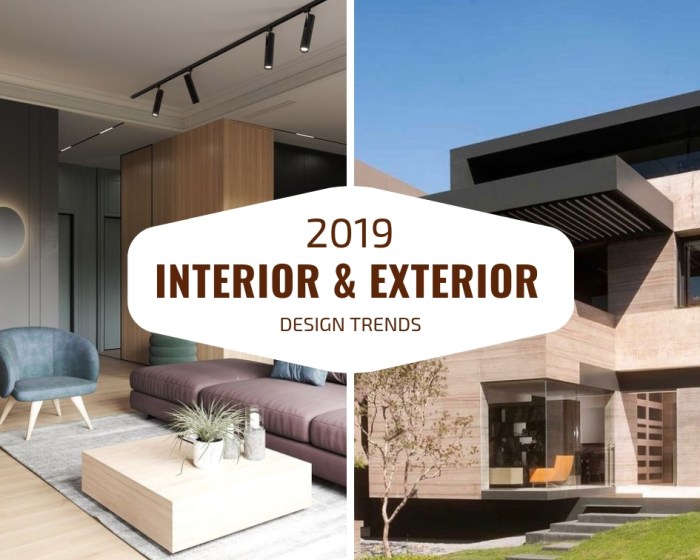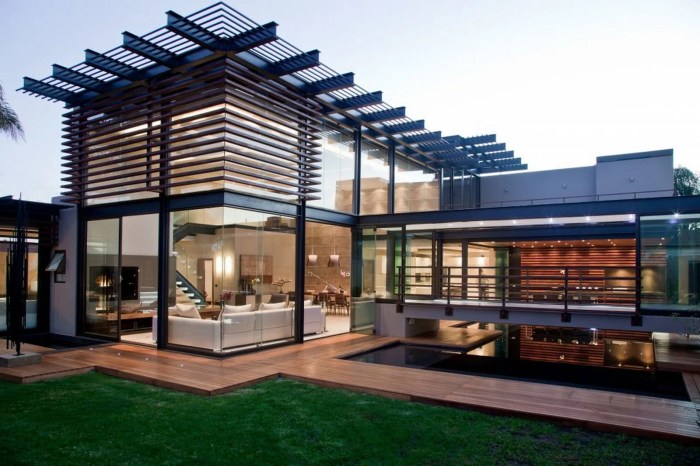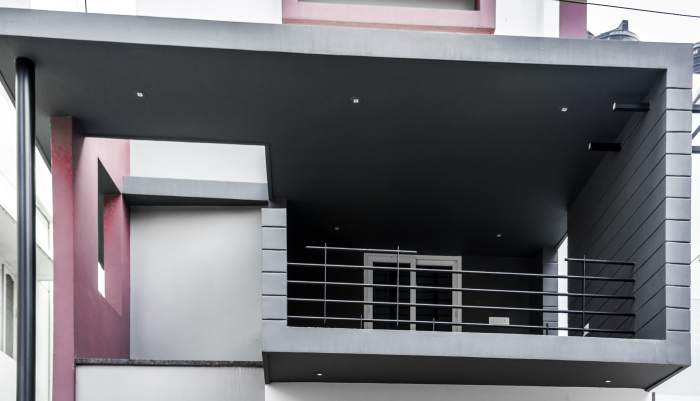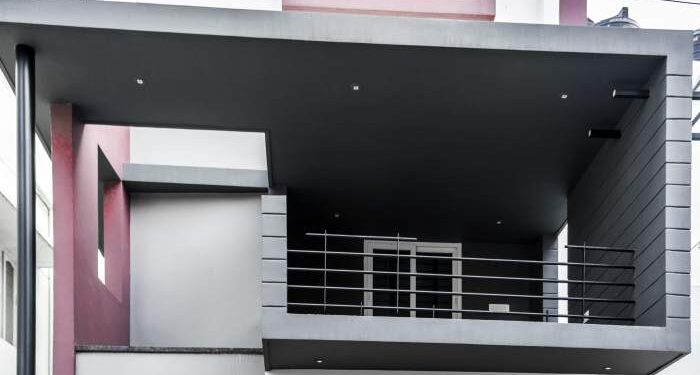Delve into the realms of interior and exterior design, where creativity knows no bounds. Discover how colors, lighting, furniture layout, and architectural elements come together to shape spaces that tell a unique story.
Interior Design

Interior design plays a crucial role in creating a welcoming and functional space that reflects the personality and style of the occupants. From colors to furniture layout and lighting, every aspect contributes to the overall ambiance of a room.
The Impact of Colors
Colors have the power to influence the mood and atmosphere of a room. For example:
- Warm colors like red, orange, and yellow can create a cozy and inviting feel.
- Cool colors such as blue and green promote a sense of calm and relaxation.
- Neutral tones like beige and gray provide a versatile backdrop for various design styles.
Furniture Layout for Space Optimization
The arrangement of furniture in a room can significantly impact its functionality and flow. Key considerations include:
- Creating designated areas for different activities like lounging, dining, and work.
- Allowing for sufficient pathways and circulation space to avoid clutter and promote ease of movement.
- Utilizing multi-functional furniture pieces to maximize space in smaller rooms.
Enhancing with Lighting
Lighting is a crucial element in interior design as it can enhance different areas of a room and set the overall mood. Considerations include:
- Using a mix of ambient, task, and accent lighting to create layers of illumination.
- Highlighting architectural features or focal points with strategically placed lights.
- Opting for adjustable fixtures to control the intensity and direction of light as needed.
Exterior Design
When it comes to the exterior design of a building, curb appeal plays a crucial role in creating a lasting impression. The exterior is the first thing that people see, and it sets the tone for what to expect inside the building.
Significance of Curb Appeal
Curb appeal refers to the attractiveness of a property as seen from the street. It includes elements such as the facade, landscaping, exterior finishes, and overall design. A well-designed exterior not only enhances the aesthetics of a building but also increases its value and desirability.
Landscaping for Enhancing the Exterior
Landscaping is a powerful tool used to enhance the exterior of a building. Well-maintained gardens, pathways, and green spaces can soften the harsh lines of a structure, create a welcoming entrance, and improve the overall ambiance. Plants, trees, and flowers can add color, texture, and visual interest to the exterior design.
Impact of Architectural Elements
Architectural elements such as windows, doors, roofs, and facades play a significant role in shaping the overall exterior design of a building. The style, size, placement, and material of these elements can determine the character, style, and architectural integrity of the structure.
Exterior Color Schemes
Color schemes on the exterior of a building can evoke specific emotions or styles. For example, warm earth tones can create a sense of warmth and coziness, while cool blues and greens can evoke a calm and tranquil atmosphere. Bold colors can make a statement and add a modern flair, while neutral tones provide a timeless and elegant look.
Materials and Textures

When it comes to interior design, the selection of materials and textures plays a crucial role in creating a cohesive and visually appealing space. Different materials offer unique characteristics that can contribute to the overall aesthetics and functionality of a room.
Additionally, texture variation adds depth and visual interest, enhancing the overall design.
Comparing Materials
Various materials are commonly used in interior design, each with its own distinct qualities. Let's compare a few:
- Wood: Known for its warmth and versatility, wood adds a natural and timeless element to a space.
- Metal: Sleek and modern, metal can bring an industrial or contemporary feel to a room.
- Glass: Transparent and reflective, glass can create a sense of openness and light in a space.
Texture Variation
Texture plays a significant role in interior design by adding tactile appeal and visual interest. By incorporating different textures such as rough, smooth, or woven, a room can feel more dynamic and inviting.
Mixing Materials for Cohesive Design
Combining various materials can result in a cohesive design aesthetic that blends different elements harmoniously. For example, pairing wood and metal can create a balanced contrast that adds interest to a room.
Selecting Appropriate Materials
It's essential to choose materials that align with the design style you want to achieve. For instance, selecting natural materials like wood for a rustic design or opting for sleek metals in a contemporary setting can enhance the overall look and feel of a space.
Trends and Styles

When it comes to interior and exterior design, staying up-to-date with the latest trends and styles is essential to creating a space that feels fresh and modern. Let's dive into the current trends and popular design styles that are shaping the world of design today.
Current Trends in Design
One of the current trends in interior design is the rise of biophilic design, which focuses on incorporating natural elements into indoor spaces to create a connection with nature. Another trend is the use of sustainable materials and eco-friendly practices to reduce the environmental impact of design projects.
Popular Design Styles
- Modern: Characterized by clean lines, minimalism, and a focus on function over form.
- Minimalist: Emphasizes simplicity, neutral colors, and a clutter-free aesthetic.
- Traditional: Draws inspiration from classic design elements, rich colors, and ornate details.
Cultural Influence on Design Trends
Cultural influences play a significant role in shaping design trends, with different regions and traditions influencing the styles and aesthetics that are popular in a given time period. For example, Scandinavian design is known for its simplicity and functionality, while Asian design often incorporates elements of nature and spirituality.
Incorporating Timeless Elements into Modern Design
To create a design that stands the test of time, it's important to incorporate timeless elements into modern spaces. This can be achieved by using classic materials like marble, wood, and brass, and opting for neutral color palettes that won't go out of style.
Additionally, focusing on quality craftsmanship and paying attention to details can help create a timeless and elegant design.
Ending Remarks
As we conclude this journey through the art of design, remember that the beauty of interior and exterior design lies in the details. Every color choice, every material selection, and every design trend contribute to the narrative of a space.
Embrace the endless possibilities that design offers and let your imagination run wild.
FAQ Resource
How does lighting impact the mood in a room?
Lighting can create different atmospheres in a room, from cozy and intimate to bright and energizing. It plays a crucial role in setting the tone for the space.
What is the significance of curb appeal in exterior design?
Curb appeal is essential as it is the first impression people get of a building. It sets the tone for what to expect inside and reflects the overall aesthetics of the property.
How can mixing materials create a cohesive design aesthetic?
Mixing materials adds depth and visual interest to a space. By combining different textures and finishes, you can achieve a harmonious and balanced design.
What are some popular design styles in interior and exterior design?
Some popular design styles include modern, minimalist, traditional, industrial, and Scandinavian, each with its own unique characteristics and aesthetics.
How do cultural influences impact design trends?
Cultural influences play a significant role in shaping design trends. They can inspire color choices, patterns, and overall design motifs that resonate with specific cultural identities.












